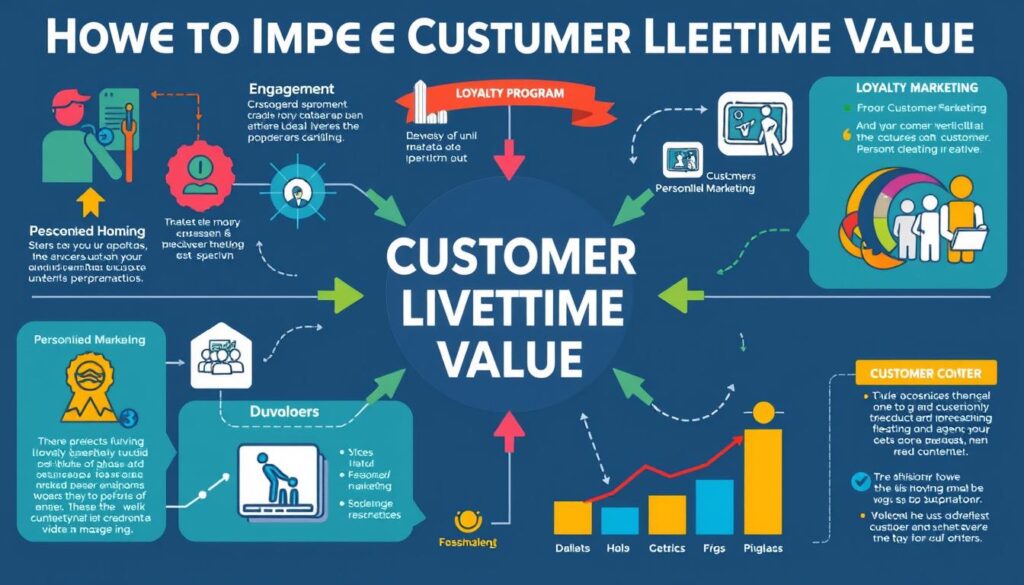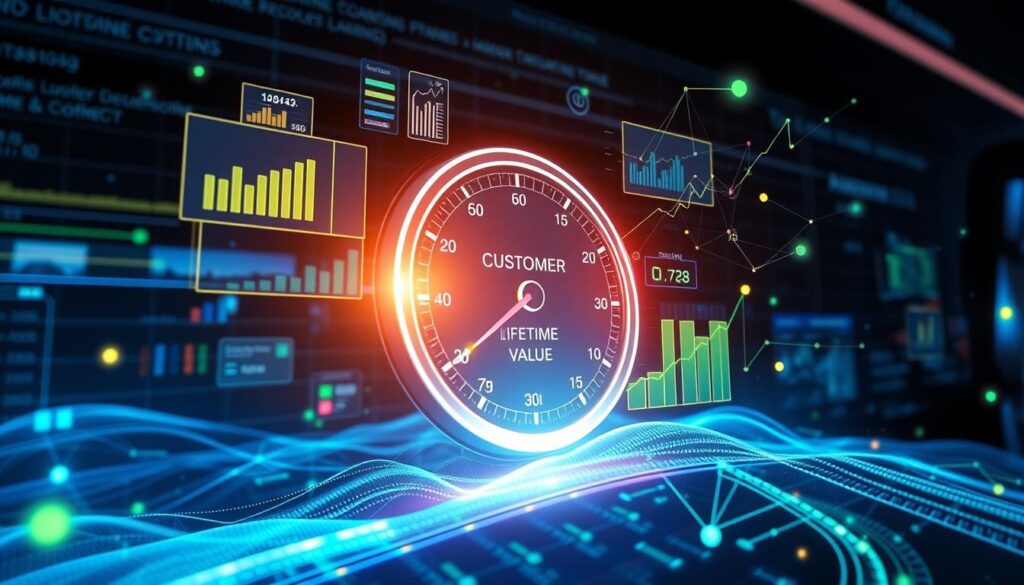A staggering 80% of a company’s future revenue comes from just 20% of its existing customers. This shows how vital understanding customer lifetime value (CLV) is for growth. By mastering CLV, you can unlock your customer base’s full potential. It’s a key metric that shows the total value of a customer over their lifetime, guiding decisions on who to acquire and keep.
Calculating customer lifetime value can drive your business forward. It’s key to understanding a customer’s total value over time. In this article, you’ll learn how to calculate CLV and use it for lasting growth.
Key Takeaways
- Understanding customer lifetime value (CLV) is crucial for business growth
- CLV calculation helps businesses make informed decisions about customer acquisition and retention
- Mastering CLV calculation can unlock the full potential of your customer base
- Customer lifetime value is a key metric that helps businesses understand the total value of a customer over their lifetime
- CLV calculation is essential for driving business growth and making informed decisions
- You can leverage CLV to make informed decisions about customer acquisition and retention
Understanding the Fundamentals of Customer Lifetime Value
To understand customer lifetime value, you need to know its definition and importance. It’s a complex formula that looks at several factors. These include the cost to get a customer, how often they stay, and how much they spend on average. Knowing this formula helps you make smart choices about getting and keeping customers, which can grow your business.
The CLV importance is huge. It helps businesses focus their marketing and use their resources wisely. By figuring out the customer lifetime value, you can spot the most valuable customers. Then, you can create special marketing plans to keep them. This way, businesses can get more from their investments and build strong relationships with customers.
What is Customer Lifetime Value?
Customer lifetime value is the total value a customer brings over their lifetime. It looks at things like how much they buy, how often they come back, and how much they spend on average. This metric shows how much money a customer can bring in and helps businesses decide who to target and keep.
Why CLV Matters for Business Growth
CLV is very important for growing a business. It helps businesses create good marketing plans, keep customers, and make more money. The formula for customer lifetime value gives a way to figure out how much each customer is worth. This lets businesses make choices based on facts and grow over time.
Key Components of CLV
The main parts of CLV are:
- Customer acquisition cost
- Retention rate
- Average order value
- Purchase frequency
Understanding these parts and calculating the customer lifetime value helps businesses. They can make better marketing plans, keep customers better, and grow for the long term.
The Business Impact of Tracking Customer Value
Tracking customer value is key for businesses. It shows the total value a customer brings over time. This helps spot areas to improve and fine-tune marketing plans. It also guides decisions on who to attract and keep as customers.
The business impact of CLV is big. It can boost growth, raise revenue, and make customers happier.
Tracking customer value brings many benefits. These include:
- Improved customer retention
- Increased revenue
- Enhanced customer satisfaction
- Data-driven decision making
Knowing the business impact of CLV lets you craft plans to boost customer value. Focus on keeping customers, personalizing experiences, and delivering top-notch service. As you track value, you’ll spot chances to tweak marketing and use resources better.
Putting customer value first and understanding the business impact of CLV keeps you ahead. Remember, tracking customer value is a continuous effort. It’s about always looking to improve. This way, you can tap into your customers’ full potential and grow your business.
| Benefits of Tracking Customer Value | Description |
|---|---|
| Improved Customer Retention | By understanding customer value, you can develop strategies to retain customers and reduce churn. |
| Increased Revenue | Tracking customer value helps you identify opportunities to increase revenue and drive growth. |
| Enhanced Customer Satisfaction | By delivering exceptional customer experiences, you can improve customer satisfaction and loyalty. |
How to Calculate Customer Lifetime Value (CLV): Step-by-Step Guide
To figure out customer lifetime value (CLV), you need to know the different ways to calculate it. The formula for customer lifetime value is key in this process. There are many methods, like looking at past data and predicting future values.
Knowing CLV is vital for businesses to see how much value a customer brings over time. This info helps them decide on marketing plans and how to use their resources.
Historical CLV Calculation Method
This method looks at a customer’s past buys and actions to guess their future worth. It’s simple and straightforward but might not always guess right about future actions.
Predictive CLV Calculation Method
This method uses data and analytics to forecast a customer’s future worth. It’s more complex than the historical method but gives a better guess at a customer’s lifetime value.
Common CLV Calculation Mistakes to Avoid
When figuring out CLV, there are mistakes to steer clear of. Not thinking about how often customers leave or not adjusting for changes in behavior are big ones. By avoiding these, businesses can get accurate CLV numbers and make smart marketing choices.
Essential Metrics That Influence Your CLV
To figure out customer lifetime value (CLV) right, you must track the right metrics. These essential metrics for CLV play a big role in your business growth. It’s crucial to know which metrics to follow and how to use them to find CLV.
Important customer value metrics include customer acquisition cost, retention rate, and average order value. These metrics give you insights into how customers behave. They help you spot where you can get better. By keeping an eye on these, you can make smart choices to boost your marketing and CLV.
Here are some key metrics to watch:
- Customer acquisition cost: The cost of getting a new customer, including marketing and sales expenses.
- Retention rate: The percentage of customers who keep coming back.
- Average order value: The average amount customers spend in one go.
By tracking these, you learn more about your customers’ likes and habits. This helps you raise customer lifetime value and grow your business.
| Metric | Description |
|---|---|
| Customer Acquisition Cost | The cost of getting a new customer |
| Retention Rate | The percentage of customers who keep coming back |
| Average Order Value | The average amount customers spend in one go |
Advanced CLV Calculation Techniques
To improve your customer lifetime value analysis, use advanced CLV calculation techniques. These methods help you calculate customer lifetime value more accurately. This way, you can make better decisions about who to acquire and keep as customers.
Advanced CLV calculation uses complex data analysis and modeling. It predicts how customers will behave and their potential lifetime value. This helps you understand your customers better and tailor your marketing to meet their needs.
Using these advanced techniques, you can understand your customers better. This leads to more targeted marketing, which boosts loyalty and retention. As a result, your business can see more revenue and growth.
- Improved customer segmentation and targeting
- Enhanced customer retention and loyalty
- Increased revenue and growth
- Better allocation of marketing resources
Advanced CLV calculation techniques unlock your customer lifetime value’s full potential. They drive business growth by making decisions based on data.
Strategies to Improve Your Customer Lifetime Value
To grow your business, focus on boosting your customer lifetime value (CLV). Customer retention is key in this effort. It helps turn one-time buyers into loyal customers.
Improving CLV involves several strategies. These include optimizing customer retention, cross-selling, and upselling. Also, enhancing the customer experience is crucial. These steps help build strong customer relationships, leading to more loyalty and revenue.
Customer Retention Optimization
Optimizing customer retention means understanding what your customers want. Collect feedback, offer personalized experiences, and provide top-notch customer service. This approach reduces churn rates and boosts loyalty.
Enhancing Customer Experience
Improving the customer experience is vital for CLV growth. Offer high-quality products, make returns and refunds easy, and ensure a smooth shopping journey. Focusing on these areas increases satisfaction, loyalty, and retention.

By using these strategies, you can enhance your CLV and drive business growth. Remember, customer retention is a key part of CLV. Prioritizing it unlocks your customer base’s full potential.
Tools and Software for CLV Calculation
Calculating customer lifetime value (CLV) is easier with the right tools and software. Tools for CLV calculation make the process smoother. They help you understand your customers’ value and make informed decisions. CRM systems and marketing automation platforms offer insights into customer behavior and preferences.
Using customer lifetime value software can highlight areas for improvement. This includes optimizing marketing campaigns and improving customer retention. These tools help you understand your customers better. You can then develop strategies to increase their lifetime value.
When choosing tools for CLV calculation, look for these features:
- Data analytics and reporting
- Customer segmentation and profiling
- Predictive modeling and forecasting
Investing in the right tools and software unlocks your CLV’s full potential. This drives business growth.
| Tool | Features | Benefits |
|---|---|---|
| CRM System | Data analytics, customer segmentation | Improved customer insights, targeted marketing |
| Marketing Automation Platform | Predictive modeling, forecasting | Enhanced customer engagement, increased revenue |
Industry-Specific CLV Considerations
Calculating customer lifetime value (CLV) is crucial, and it depends on your industry. Each field has its own traits that affect CLV. For example, e-commerce CLV is key for online stores. It shows the value of customers over time, guiding marketing and retention plans.
In e-commerce, industry-specific CLV helps spot valuable customers. It also guides targeted marketing to keep and get them. Important e-commerce CLV factors include:
- Average order value
- Customer retention rate
- Customer acquisition cost
- Lifetime purchase frequency
By looking at these, you can understand your customers’ lifetime value. This knowledge helps drive your business forward.

Other industries like SaaS and retail also benefit from industry-specific CLV. It helps them figure out CLV and make smart choices about keeping and getting customers.
| Industry | Key Factors to Consider |
|---|---|
| E-commerce | Average order value, customer retention rate, customer acquisition cost |
| SaaS | Customer lifetime value, monthly recurring revenue, churn rate |
| Retail | Average transaction value, customer loyalty, customer retention rate |
Integrating CLV into Your Business Strategy
Driving growth, increasing revenue, and improving customer satisfaction are key goals. Integrating CLV into business strategy is essential for achieving these. It helps you understand the customer lifetime value importance and unlock your customer base’s full potential.
Start by identifying key areas where integrating CLV into business strategy can make a big difference. Focus on:
- Customer retention optimization
- Cross-selling and upselling techniques
- Customer experience enhancement
By focusing on these areas, you can create a customer-centric approach. This drives long-term growth and revenue. Remember, customer lifetime value importance is crucial for your bottom line.
Common Challenges in CLV Implementation
When you start using customer lifetime value (CLV), you might face some common problems. These issues can slow you down. But, with the right approach, you can get past them. One big hurdle is gathering and understanding data, which can take a lot of time and effort.
Data Collection Issues
There are many reasons why collecting data can be hard. Sometimes, the information you get is not complete or correct. To fix this, you can check your data for errors and make your data collection process smoother.
Analysis Complexity
Another challenge is making sense of the data. This can be solved by using advanced tools like machine learning. These tools help you understand what your customers like and do.
Resource Allocation
Having enough resources is key to using CLV well. You need people, technology, and money to make it work. By managing your resources well, you can beat these challenges and reach your goals.
Some common challenges in CLV implementation include:
- Data quality issues
- Insufficient resources
- Complexity of analysis
- Lack of skilled personnel
By knowing these challenges and finding ways to solve them, you can grow your business and make your customers happier. Always keep your focus on improving customer value. Keep checking and improving your CLV plans for lasting success.
| Challenge | Solution |
|---|---|
| Data collection issues | Implement data validation techniques and streamline data collection processes |
| Analysis complexity | Use advanced analytics tools and techniques, such as machine learning and predictive modeling |
| Resource allocation | Ensure necessary resources, including personnel, technology, and budget, are allocated effectively |
Conclusion: Maximizing Business Growth Through CLV Mastery
Mastering customer lifetime value (CLV) is key to growing your business. It boosts revenue and makes customers happier. By knowing how to calculate CLV and using it in your strategy, you can make the most of your customers.
CLV is more than just a number. It helps you make smart choices, improve marketing, and give great customer service. Tracking and improving CLV lets you find your best customers and use resources wisely.
CLV is your guide in the changing business world. Knowing your customers’ value helps you make choices that grow your business. This way, you stay ahead and ensure your business thrives for years to come.

